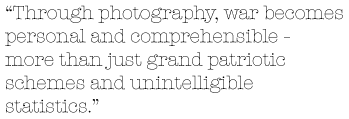







| |
|
|
|
|
|
|
|
|
|||||||||||
| |
|
|
|
|
|||||||||||||||
 |
|
|
|
||||||||||||||||
| |
|
|
 |
|
|||||||||||||||
 |
|
||||||||||||||||||
 |
 |
|
|||||||||||||||||
| |
|
||||||||||||||||||
| |
|
|
|||||||||||||||||
| |
|
||||||||||||||||||
| |
|
||||||||||||||||||
| |
|
|
|||||||||||||||||
| |
|
||||||||||||||||||
| |
|
||||||||||||||||||
| |
|
|
|
||||||||||||||||
| |
 |
|
|||||||||||||||||
 |
|
|
|
||||||||||||||||
 |
|
|
|
||||||||||||||||
| |
|
||||||||||||||||||
| |
|
||||||||||||||||||
| |
|
|
|
|
|
|
|
|
|
|
|
|
|
|
|
|
|
|
|
|
|
'Documentary' photography usually refers to eyewitness proof that something as happened. The latin root of the word, 'Docere' means to teach, and so the documentary photograph essentially instructs the viewer "on some aspect of society in which truth is revealed." (Rothstein) Thus, documentary photography becomes important in terms of historical evidence. But whether photographs can convery the entire 'truth' is questionable - manipulated or not, the very act of managing a camera with a subjective eye and hand imparts an inherent bias to the image. Photographs must always be seen in a context, and while images aren't literally 'created,' the important distinction is that photographs are assigned meaning. And so this 'truth' is in fact 'truth' in the reality of the photographer, and of the social context in which the photograph is taken. Most of the viewing public, however, tend to take in most pictures at face value. Documentary photographs therefore become simply more than one person's testament to war - they have the potential to become visual statements of fact, and can thus be very powerful pieces of evdience in the history of a nation: "The accumulation of visual information to make a strong and effective statement is one of the assets of documentary photography." (Rothestein) This idea of the documentary photograph as a photographers personal testament to war, makes the camera a very powerful weapon. As evidenced during the Vietnam War, photographs can be used as tools to sway public opinion, acting as a challenge to national policy and serving as moral lessons about war. The documentary tradition is thus described as "the desire to create active interpretation of the world in whcih we live." (Moeller) It is said that the best war photography is an epiphany of life and death. It also forces us to acknowledge the faces of war, and individualizes the mass of people involved. War photography thus serves several practical functions: 1) it brings images of destruction home. 2) It allows us to see the consequences of our actions. 3) It visualizes the wasteland of battle. 4) It shows us what to expect of War. 5) It makes us acknowledge what we've done. And finally, 6) it visualizes and verifies events for the world's audience. (Rothstein) Most of war photography tends to be black and white, for what may seem like obvious reasons. Not only is black and white more visually mystifying (therefore requiring the viewer to engage in its interpretation) but the start constrast also seems to convey a more realistic message. Color, on the otherhand, has a picturesque quality about it that isn't as aesthetically arresting as the effect of black and white photography. This sense of 'realism' is also an integral part of the documentary tradition. It moves beyond staged groupings of people to taking arbitrary slices of life. The fragmentary nature of realism is therefore moving and powerful, for the photographer is hoping to capture that 'decisive' moment, something which Robert Capa was a master of. Photographers are in that sense intermediaries as between the public and the battleground, the soldiers. Having the understand that mentality, the ability to understand both world, what inspires sympathy, horror and empathy is what gives them that power. “A dilemma for such war photographers who lose sight of the horror and inhumanity of their environment is that they also lose their ability to distinguish sanity from insanity, kindness from brutality. Without an outraged perspective, without the belief that the world is mad, war seems normal. Many war correspondents feel they need to be rotated back home from their assignments because they, as well as soldiers, can become disoriented.” (Rothstein) Most often, war photography depicts the impermanence of life amidst war. “Photographs of war have captured a visual essence but not the total experience of war. The camera takes a picture out of context, a moment out of time. And it often does not take just any moment; it takes, instead, a “decisive moement.” A feeting second – such as the instant of the shooting of the Vietcong prisoner by South Vietnamese General Loan – is arrested and analyzed. In photography, reality becomes hypperreality."
|
 |
|
| ....... |
Photojournalism | The Photographers | Media | Representation | Bibliography | Contact Info
Return to the Top